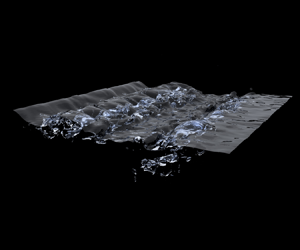Article contents
The turbulent bubble break-up cascade. Part 2. Numerical simulations of breaking waves
Published online by Cambridge University Press: 16 February 2021
Abstract

Breaking waves generate a distribution of bubble sizes that evolves over time. Knowledge of how this distribution evolves is of practical importance for maritime and climate studies. The analytical framework developed in Part 1 (Chan, Johnson & Moin, J. Fluid Mech., vol. 912, 2021, A42) examined how this evolution is governed by the bubble-mass flux from large- to small-bubble sizes which depends on the rate of break-up events and the distribution of child bubble sizes. These statistics are measured in Part 2 as ensemble-averaged functions of time by simulating ensembles of breaking waves, and identifying and tracking individual bubbles and their break-up events. The large-scale break-up dynamics is seen to be statistically unsteady, and two intervals with distinct characteristics were identified. In the first interval, the dissipation rate and bubble-mass flux are quasi-steady, and the theoretical analysis of Part 1 is supported by all observed statistics, including the expected  $-10/3$ power-law exponent for the super-Hinze-scale size distribution. Strong locality is observed in the corresponding bubble-mass flux, supporting the presence of a super-Hinze-scale break-up cascade. In the second interval, the dissipation rate decays, and the bubble-mass flux increases as small- and intermediate-sized bubbles become more populous. This flux remains strongly local with cascade-like behaviour, but the dominant power-law exponent for the size distribution increases to
$-10/3$ power-law exponent for the super-Hinze-scale size distribution. Strong locality is observed in the corresponding bubble-mass flux, supporting the presence of a super-Hinze-scale break-up cascade. In the second interval, the dissipation rate decays, and the bubble-mass flux increases as small- and intermediate-sized bubbles become more populous. This flux remains strongly local with cascade-like behaviour, but the dominant power-law exponent for the size distribution increases to  $-8/3$ as small bubbles are also depleted more quickly. This suggests the emergence of different physical mechanisms during different phases of the breaking-wave evolution, although size-local break-up remains a dominant theme. Parts 1 and 2 present an analytical toolkit for population balance analysis in two-phase flows.
$-8/3$ as small bubbles are also depleted more quickly. This suggests the emergence of different physical mechanisms during different phases of the breaking-wave evolution, although size-local break-up remains a dominant theme. Parts 1 and 2 present an analytical toolkit for population balance analysis in two-phase flows.
- Type
- JFM Papers
- Information
- Copyright
- © The Author(s), 2021. Published by Cambridge University Press
References
REFERENCES
- 38
- Cited by


